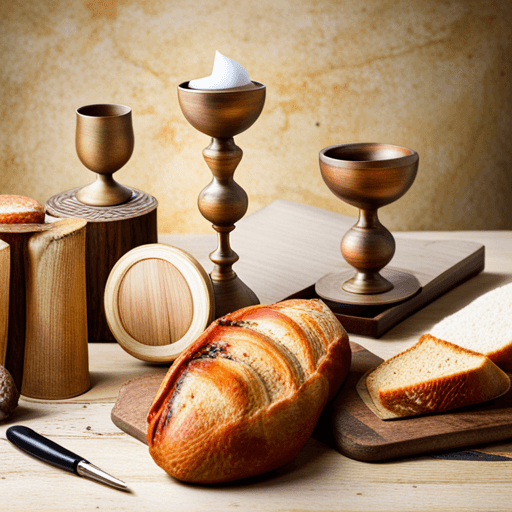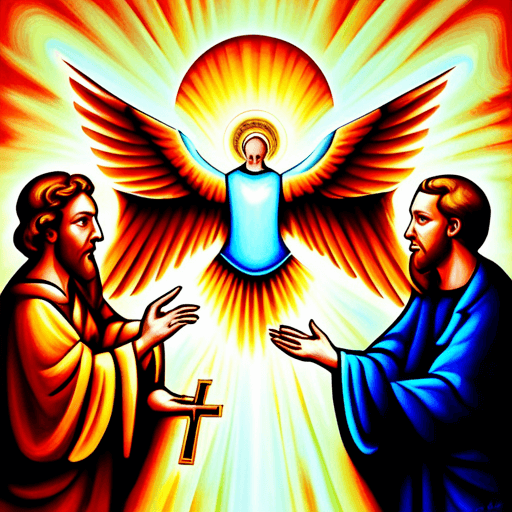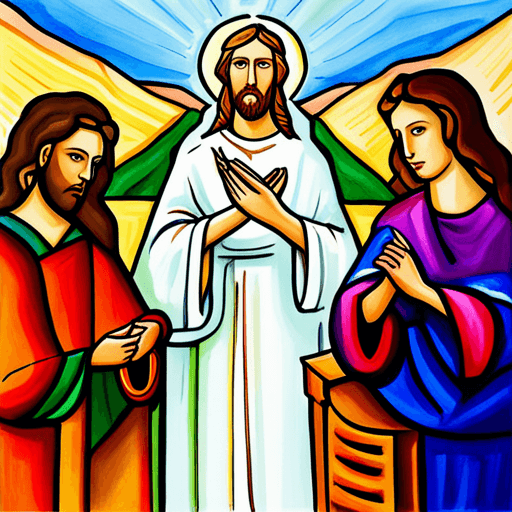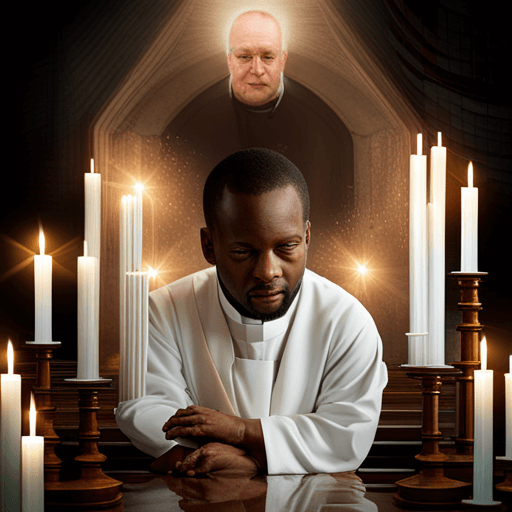Do you ever wonder about the origins and meaning of the Eucharist? As a central sacrament in Christianity, it holds significant importance for followers around the world. Understanding its historical development can deepen your appreciation for its significance and provide insight into the beliefs of different denominations.
The Eucharist has roots in Jewish tradition, as Jesus was a practicing Jew who participated in Passover meals with his disciples. The Last Supper, where Jesus shared bread and wine with his followers before his crucifixion, is considered by Christians to be the foundation of the Eucharist.
From there, the ritual evolved over time with various interpretations and practices among different Christian groups. Gaining insight into these developments can help us better understand our own beliefs and those of others within our faith community.
The Jewish Roots of the Eucharist
Get ready to discover the Jewish roots of this sacred ritual as we delve into its history.
The Eucharist, also known as Holy Communion or the Lord’s Supper, has deep connections to the Jewish Passover and the Seder meal. Jesus and his disciples celebrated Passover together before his crucifixion, and it was during this meal that Jesus instituted the Eucharist.
The Passover meal is a commemoration of God’s deliverance of the Israelites from slavery in Egypt. During this meal, participants would eat unleavened bread (matzah) and drink wine, both of which symbolize different aspects of their liberation.
Similarly, in the Eucharist, Christians partake in bread and wine that represent Christ’s body and blood given for their salvation. The Seder meal influence can be seen in several elements of the Eucharistic liturgy such as washing hands before eating and blessing over bread and wine.
By understanding these Jewish roots, we can gain a deeper appreciation for this sacred ritual that connects us to our spiritual ancestors.
The Last Supper and Jesus’ Sacrifice
You’re probably familiar with the story of The Last Supper, but did you know that it serves as the foundation for understanding Jesus’ sacrifice?
During this final meal with his disciples, Jesus broke bread and shared wine with them, saying that these elements represented his body and blood. This was a symbolic act to foreshadow the events that would unfold in just a few short hours.
Jesus knew that he would soon be betrayed by one of his own, Judas Iscariot. He also knew that he would be arrested, tried and ultimately crucified as punishment for claiming to be the Son of God.
By offering his body and blood to his disciples during The Last Supper, Jesus was essentially offering himself up as a sacrifice for all humanity. Through this selfless act, he hoped to redeem mankind’s sins and bring about salvation for all who believed in him.
The symbolism of bread and wine continues to play an important role in Christian worship today, reminding believers of Christ’s ultimate sacrifice on their behalf.
In conclusion, understanding The Last Supper is key to understanding Jesus’ sacrifice on the cross. By breaking bread and sharing wine with his disciples at this final meal together, Jesus was preparing them for what was to come while also setting an example of selflessness and love.
Today, Christians around the world continue to celebrate this moment through communion services where they partake in bread and wine as symbols of Christ’s enduring love for humanity.
The Evolution of Eucharistic Rituals
As you delve into the current section, you’ll discover how the Eucharistic rituals have evolved over time, providing a deeper understanding of the significance and symbolism behind this important sacrament.
Cultural influences on eucharistic rituals have played a significant role in shaping its practices across different regions and periods. For example, during the Middle Ages, there was a strong emphasis on the visual and sensory aspects of the Eucharist, which led to the development of elaborate ceremonies involving incense, music, and processions. These practices were influenced by the grandeur of imperial Roman court ceremonies as well as local customs.
Changes in eucharistic practices over time can also be seen in how it is administered and received. In early Christian communities, it was common for people to partake in small groups or even at home with their families. However, during the medieval period, only ordained priests were allowed to administer communion to ensure that it was done properly according to church doctrine.
Today’s eucharistic rituals reflect a more relaxed approach where laypeople are encouraged to participate actively in various ways such as receiving bread or wine from communion ministers or participating in communal prayers and hymns.
Despite these changes over time, one thing remains constant -the Eucharist continues to play an essential role in Christian worship and identity around the world today.
Theological Interpretations of the Eucharist
Discover the rich depth of theological interpretations behind the Eucharist, and be moved by the spiritual significance that this sacrament holds for believers.
At its core, the Eucharist is a sacramental presence of Christ, where his body and blood are truly present in the bread and wine. This belief is rooted in scripture and has been upheld by many theologians throughout history.
However, there have also been controversies surrounding this doctrine, particularly with regards to transubstantiation. Some believe that the substance of bread and wine is completely transformed into the substance of Christ’s body and blood during consecration, while others argue that there is only a symbolic representation of Christ’s presence.
These debates have led to divisions within Christianity, but ultimately they serve as a reminder of how seriously believers take their understanding of this sacred ritual.
Differences and Similarities Among Christian Denominations
Take a look at how different Christian denominations approach the sacrament, and see how their varying beliefs and practices reflect their unique perspectives on faith and worship.
From the Catholic Church’s belief in transubstantiation to the Protestant view of communion as a symbolic act, there are numerous denominational practices when it comes to the Eucharist.
Some churches use wine while others use grape juice. Some offer individual cups while others have congregants drink from one shared chalice.
Theological variations also play a role in these differences. Orthodox churches, for example, believe that bread and wine become the actual body and blood of Christ but do not attempt to explain how this happens through philosophy or science.
On the other hand, Lutherans understand the elements of communion as being both physical bread and wine and also spiritually present through faith in Jesus Christ.
These differences among Christian denominations highlight not only theological variances but also cultural distinctions between groups of believers.
Frequently Asked Questions
How often should one receive the Eucharist?
How often should you receive the Eucharist? The frequency of receiving the sacrament varies among individuals and is ultimately a personal decision. However, it is important to approach the Eucharist with proper preparation, including examining one’s conscience and being in a state of grace through confession if necessary.
Regular reception of the Eucharist can deepen one’s relationship with Christ and foster spiritual growth, but it’s also important to avoid treating it as routine or simply going through the motions. Ultimately, the decision on frequency should be guided by prayerful reflection on one’s own spiritual needs and readiness to receive this sacred sacrament.
Can non-Christians partake in the Eucharist?
As a non-Christian, you may wonder if you’re allowed to partake in the Eucharist. The answer varies depending on theological considerations and interfaith implications.
Some Christian denominations believe that only baptized Christians can receive the sacrament, while others welcome all who wish to participate. It’s important to respect the beliefs of each individual community and ask for guidance if you’re unsure whether or not it’s appropriate for you to take part.
Ultimately, the decision is yours, but it’s worth considering what it means to be a member of a particular faith tradition before taking part in one of its most sacred practices.
Is the Eucharist a symbolic or literal representation of Jesus’ body and blood?
Do you believe that the Eucharist is a literal or symbolic representation of Jesus’ body and blood? This question has theological implications as it speaks to the very heart of Christian belief.
If you believe that the bread and wine actually become the body and blood of Christ, then this is a literal representation. However, if you view the Eucharist as merely a symbol, then it is a symbolic representation.
The debate over this topic has been ongoing for centuries, with theologians on both sides arguing their points fervently. Ultimately, what one believes about the nature of the Eucharist can have significant impacts on their faith and relationship with God.
What is the significance of the bread and wine used in the Eucharist?
When it comes to the significance of the bread and wine used in the Eucharist, there are two key elements to consider: Origins & Evolution and Theological Significance.
Historically, bread and wine were common staples in ancient cultures, so their use in religious ceremonies was not unusual. Over time, however, these elements took on a deeper meaning within Christian theology as symbols of Jesus’ body and blood.
This theological significance is rooted in the Last Supper, where Jesus shared bread and wine with his disciples before his crucifixion. For believers today, participating in communion or the Eucharist is a way to connect with this historical event and reaffirm their faith through this symbolic act of remembrance.
Ultimately, whether one views the Eucharist as symbolic or literal representation of Jesus’ body and blood, its importance lies in its ability to bring individuals together as a community united by their shared beliefs.
Are there any specific prayers or rituals that must accompany the reception of the Eucharist?
When receiving the Eucharist, there are prayer customs and rituals that have developed over time. These customs vary between different Christian denominations and even within specific communities. Some may kneel or stand, while others may bow their heads in reverence.
Historically, there have been various prayers said before and after receiving the Eucharist, such as the Lord’s Prayer or the Anima Christi. However, these prayers aren’t always required and can be left to personal preference or tradition.
Ultimately, the act of receiving the Eucharist is a deeply personal experience that can be accompanied by whatever prayer or ritual feels most meaningful to an individual’s faith journey.
Conclusion
So, now that you’ve got a historical overview of the Eucharist, what does it all mean? Through understanding the Jewish roots and Jesus’ sacrifice at the Last Supper, we can see how this ritual has evolved over time.
Theological interpretations have varied among Christian denominations, but ultimately the Eucharist serves as a symbol of unity and remembrance for all who partake in it.
As you reflect on your own beliefs and experiences with the Eucharist, consider how its significance has changed throughout history and across different cultures. What does it mean to you personally?
How do you approach this ritual in your own faith practice? By delving into the rich history and theology of the Eucharist, we can deepen our understanding of its meaning and significance in our lives today.




